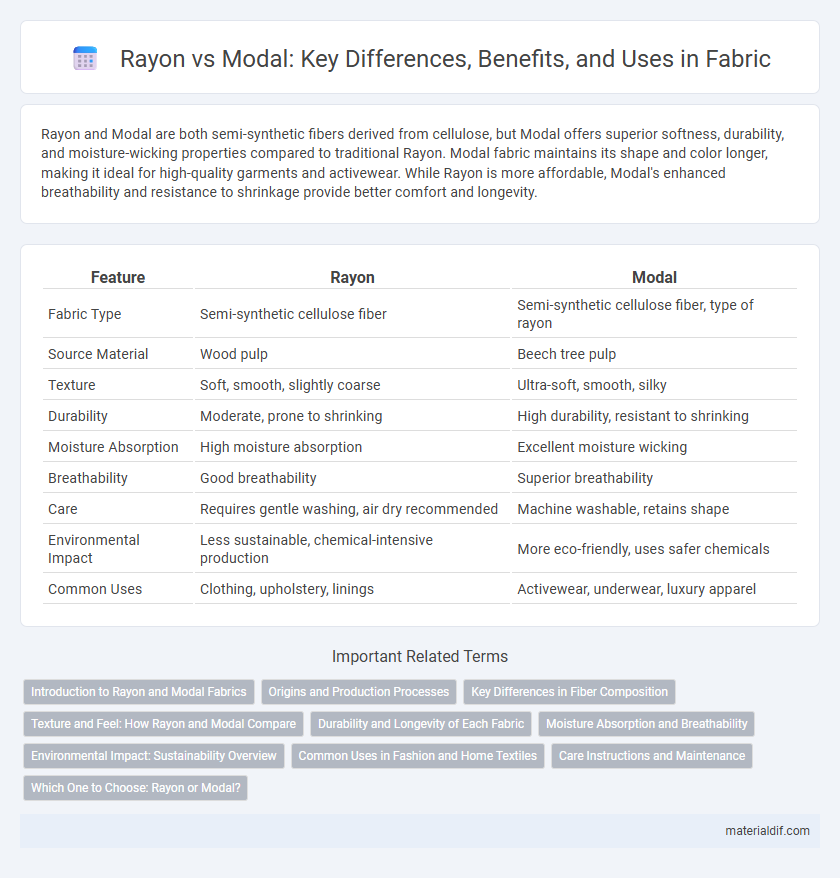Rayon and Modal are both semi-synthetic fibers derived from cellulose, but Modal offers superior softness, durability, and moisture-wicking properties compared to traditional Rayon. Modal fabric maintains its shape and color longer, making it ideal for high-quality garments and activewear. While Rayon is more affordable, Modal's enhanced breathability and resistance to shrinkage provide better comfort and longevity.
Table of Comparison
| Feature | Rayon | Modal |
|---|---|---|
| Fabric Type | Semi-synthetic cellulose fiber | Semi-synthetic cellulose fiber, type of rayon |
| Source Material | Wood pulp | Beech tree pulp |
| Texture | Soft, smooth, slightly coarse | Ultra-soft, smooth, silky |
| Durability | Moderate, prone to shrinking | High durability, resistant to shrinking |
| Moisture Absorption | High moisture absorption | Excellent moisture wicking |
| Breathability | Good breathability | Superior breathability |
| Care | Requires gentle washing, air dry recommended | Machine washable, retains shape |
| Environmental Impact | Less sustainable, chemical-intensive production | More eco-friendly, uses safer chemicals |
| Common Uses | Clothing, upholstery, linings | Activewear, underwear, luxury apparel |
Introduction to Rayon and Modal Fabrics
Rayon and modal are both semi-synthetic fibers derived from cellulose, commonly used in textile manufacturing for their breathability and softness. Rayon, created through the regeneration of natural cellulose, is known for its smooth texture and versatility in fashion applications. Modal, a type of rayon made from beech tree pulp, offers higher durability and moisture-wicking properties, making it a favored choice for activewear and luxury garments.
Origins and Production Processes
Rayon, derived from cellulose sources such as wood pulp, undergoes a chemical-intensive process involving dissolving cellulose in chemicals like sodium hydroxide and carbon disulfide to create viscose fibers. Modal, a type of rayon, is produced primarily from beech tree pulp and utilizes a more environmentally friendly process with efficient chemical recovery systems, resulting in stronger and more durable fibers. Both fibers share a wood-based origin, but Modal's advanced production methods contribute to enhanced softness and fabric resilience.
Key Differences in Fiber Composition
Rayon is made from regenerated cellulose fibers derived primarily from wood pulp, offering a versatile and cost-effective fabric option. Modal, a type of rayon, differs by being crafted specifically from beech tree pulp through a more refined process, resulting in stronger, more durable fibers with enhanced resistance to shrinkage and fading. The key difference in fiber composition lies in modal's higher concentration of cellulose and improved fiber structure, which provides superior softness and moisture-wicking properties compared to standard rayon.
Texture and Feel: How Rayon and Modal Compare
Rayon boasts a smooth texture with a silk-like sheen, offering a soft, breathable feel ideal for lightweight garments. Modal, a type of rayon, enhances this softness with a more supple, fine texture that resists pilling and maintains a silky touch even after multiple washes. Both fabrics provide comfort, but Modal's luxurious drape and durability give it an edge in softness and long-lasting feel.
Durability and Longevity of Each Fabric
Rayon, made from regenerated cellulose fibers, offers moderate durability but tends to weaken when wet, reducing its longevity with frequent washing. Modal, a type of rayon derived from beech tree pulp, features enhanced fiber strength and greater resistance to shrinkage and pilling, significantly extending the fabric's lifespan. Superior moisture absorption and breathability in modal also contribute to maintaining fabric integrity over time compared to standard rayon.
Moisture Absorption and Breathability
Modal fabric offers superior moisture absorption compared to Rayon, due to its higher cellulose content derived from beech trees, which allows it to wick sweat more effectively. Modal also provides enhanced breathability, enabling better air circulation and comfort during wear. These properties make Modal a preferred choice for activewear and undergarments over traditional Rayon.
Environmental Impact: Sustainability Overview
Rayon production involves significant chemical usage and water consumption, leading to higher environmental pollution compared to modal, which is a type of rayon made from beech tree pulp using more eco-friendly processes. Modal fibers are often biodegradable, sourced from sustainably managed forests, and require less water and energy, making them a more sustainable fabric option. Choosing modal over traditional rayon contributes to reduced deforestation and lower carbon emissions in the textile industry.
Common Uses in Fashion and Home Textiles
Rayon is widely used in fashion for its versatility and silk-like feel, commonly found in dresses, blouses, and linings, as well as in home textiles like curtains and upholstery. Modal, a type of rayon derived from beech trees, is favored for its softness and durability in activewear, underwear, and bed linens. Both fabrics offer breathable comfort, but Modal's enhanced moisture-wicking properties make it particularly popular in performance and intimate apparel.
Care Instructions and Maintenance
Rayon requires gentle hand washing or delicate machine cycles with cold water to prevent shrinking and weakening of fibers, while Modal offers more durability and can usually be machine washed with warm water without significant damage. Both fabrics benefit from air drying to maintain their shape and softness, but Modal resists pilling and fading better over time, reducing the need for special care. Avoiding high heat during ironing preserves the integrity of Rayon, whereas Modal withstands low to medium heat ironing for wrinkle removal.
Which One to Choose: Rayon or Modal?
Choosing between rayon and modal depends on the intended use and desired fabric qualities; rayon offers a smooth texture and drapes well but can be less durable and prone to shrinking, while modal is a type of rayon made from beech tree pulp, known for its superior softness, higher moisture absorbency, and improved resistance to shrinking and pilling. Modal fabric is often preferred for activewear and underwear due to its breathable, lightweight nature and enhanced comfort, whereas rayon is commonly used for dresses, blouses, and linings that require a silky appearance. For a fabric that balances softness, durability, and moisture-wicking properties, modal is generally the better choice over traditional rayon.
Rayon vs Modal Infographic

 materialdif.com
materialdif.com